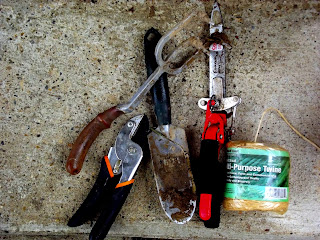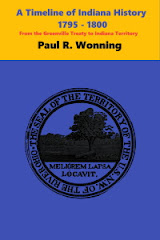The 1795 Treaty of Greenville opened up most of the lands in the future state of Ohio to settlement, forcing the native tribes further west. The treaty line also opened up a small area in what would become the southeast corner of Indiana. In the years after the signing of the treaty the population of the Northwest Territory grew as the future state of Ohio neared birth.
January 1795 - Native Leaders Gather at Fort Greenville
Israel Putnam Establishes First Library in Northwest Territory
May 02, 1795 – Governor St. Clair Has Concern over Illicit Trade
February 1795 - Miami Chief Pacanne Taken to Detroit
March 31 - 1795-French Grant
June 16, 1795 - Negotiation Council Opens
June 17, 1795 - Pottawattamie Chief New Corn Arrives
June 23, 1795 - Little Turtle, La Gris Arrived at Fort Greenville
June 24, 1795 - Senate Ratifies Jay Treaty
June 25, 1795 - Wayne Explains Camp Procedure
June 30, 1795 - Native Chiefs Ask for Wine
July 03, 1795 - General Wayne Informs Native Chiefs about Independence Day Celebration
July 15, 1795 - General Wayne Proposes Treaty Terms
July 18, 1795 - Treaty of Greenville - Treaty of Muskingum River (Fort Harmar) Debated
July 19, 1795 - Treaty of Greenville - Blue Jacket and General Wayne Confer
July 20, 1795 - Treaty of Greenville - General Wayne's Speech to the Council
July 21, 1795 - Treaty of Greenville - Discussion About Lands Ceded by Treaty of Muskingum River
July 22, 1795 – Little Turtle and Tarke Speak
July 23, 1795 - General Discussion by the Chiefs
July 25, 1795 - General Wayne Clarifies the Land Boundaries
July 27, 1795 - Boundaries Explained
July 28, 1795 - General Discussion Among Chiefs
July 29, 1795 - The Chiefs Answer
July 30, 1795 - Agreement
August 03, 1795 - Treaty of Greenville Concluded
August 07, 1795 – Greenville Treaty Copies Distributed
August 10, 1795 - Record of Proceedings Certified
August 12, 1795 - Chiefs Ask for Traders
August 25, 1795 - Northwest Territorial Assembly Adjourns - Maxwell's Code Becomes Law
September 09, 1795 - Shawnees Return Prisoners
September 28, 1795 - President Receives Copy of Treaty of Greenville
October 02, 1795 - Secretary of State Letter to the President
November 17, 1795 - Postmaster General Concedes Mail’s Tardiness
November 25, 1795 - William Henry Harrison Marries Anna Symmes
December 1795 - Meriwether Lewis Joins Chosen Rifle Company
January 06, 1796 - Postmaster General Letter - Impracticality of Mail Routes on Ohio River
February 29, 1796 - Jay Treaty Effective
March 25, 1796 - Colonel Ebenezer Zane Submits Letter Petitioning To Build a Road
April 1796 - Chillicothe Ohio Established
April 1796 - British Begin Building Fort Amherstburg
May 18, 1796 - Land Act of 1796
June 01, 1796 - Amendment Land Act of 1796
June 01, 1797 - Israel Ludlow Arrived at Loromie's Creek to Begin Survey
June 15, 1797 - Israel Ludlow Begins Surveying the Greenville Treaty Line
July 01, 1796 - William Clark Resigns from Army
July 11, 1796 - British Evacuate Fort Detroit
July 13, 1796 - American Force Occupies Fort Detroit
July 17, 1796 - Colonel John Hamtramck Officially Takes Command at Detroit
August 1796 - William Henry Harrison Becomes Commander of Fort Washington
August 13, 1796 - General Wayne Arrives Detroit
December 15, 1796 - Death of General Wayne
November 05, 1796 - Rufus Putnam Appointed Surveyor General
January 25, 1797 - Putnam Requests Permission to Begin Survey
March 14, 1797 - The Secretary of the Treasury Replies to Putnam
Late March 1797 Putnam Establishes his Office in Marietta
May 07, 1797 - Congress Approves Funding for Zane's Trace
July 10, 1797 - Israel Ludlow Arrives at Loramie's Store
July 10, 1797 - Adams County Created
July 29, 1797 - Jefferson County Created
February 04, 1798 - Calvin Fletcher Born
June 01, 1798 - William Henry Harrison Resigns From Army
June 26, 1798 - Harrison Receives Appointment as Secretary of the Northwest Territory
October 02, 1798 - Théodore Guérin Born
October 1798 - Israel Ludlow Surveys True Meridian That Became Indiana/Ohio State Line
October 28, 1798 - Levi Coffin Born
October 29, 1798 - St. Claire Orders First Elections Held for Assembly
November 22, 1798 - Silver Creek Church Established - Clarksville
December 17, 1798 - First Election Northwest Territory
1799 - Ephraim Kibbey Begins Cutting Kibbey's Trace
January 22, 1799 - First Northwest Territory Legislature Meets
June 26, 1799 - William Henry Harrison Appointed Secretary of Northwest Territory
February 4, 1799 - First Northwest Territory Chooses Council Members
March 02, 1799 - President John Adams Picks 5 Council Member
March 03, 1799 - United States Senate Confirms the List of Northwest Territory Council
April 24, 1799 - David Wallace Born - Sixth Indiana Governor
June 12, 1799 - James Washington Cockrum Born - Became Instrumental Figure Underground Railroad
September 16, 1799 - First Legislative Assembly of Northwest Territory
September 24, 1799 - Assembly Meets and Organizes
October 03, 1799 - Northwest Territory Legislature Elects Harrison as First Delegate to Congress
November 28, 1799 - John Rice Jones Appointed to Carry Mail
1799-October -December 12 - First Legislative Session
December 14, 1799 - Men Required to Work Two Days Each Year on Roads
December 19, 1799 - Northwest Assembly Adjourns
December 24, 1799 - Harrison Proposes Changes to Land Laws
February 28, 1800 - Second Census Authorized
March 22, 1800 - Buffalo (Vincennes) Trace Designated a Post Road
Marcy 03, 1800 - Congressional Report Recommends Splitting Northwest Territory
May 07, 1800 - Bill to Divide Northwest Territory - Creates Indiana Territory
Acknowledgements
About the Author
Mossy Feet Books Catalogue
Sample Chapter
Short History of Roads and Highways - Indiana Edition
Indian Trails, Pioneer Traces and Indiana Highways
Indiana History Series


















